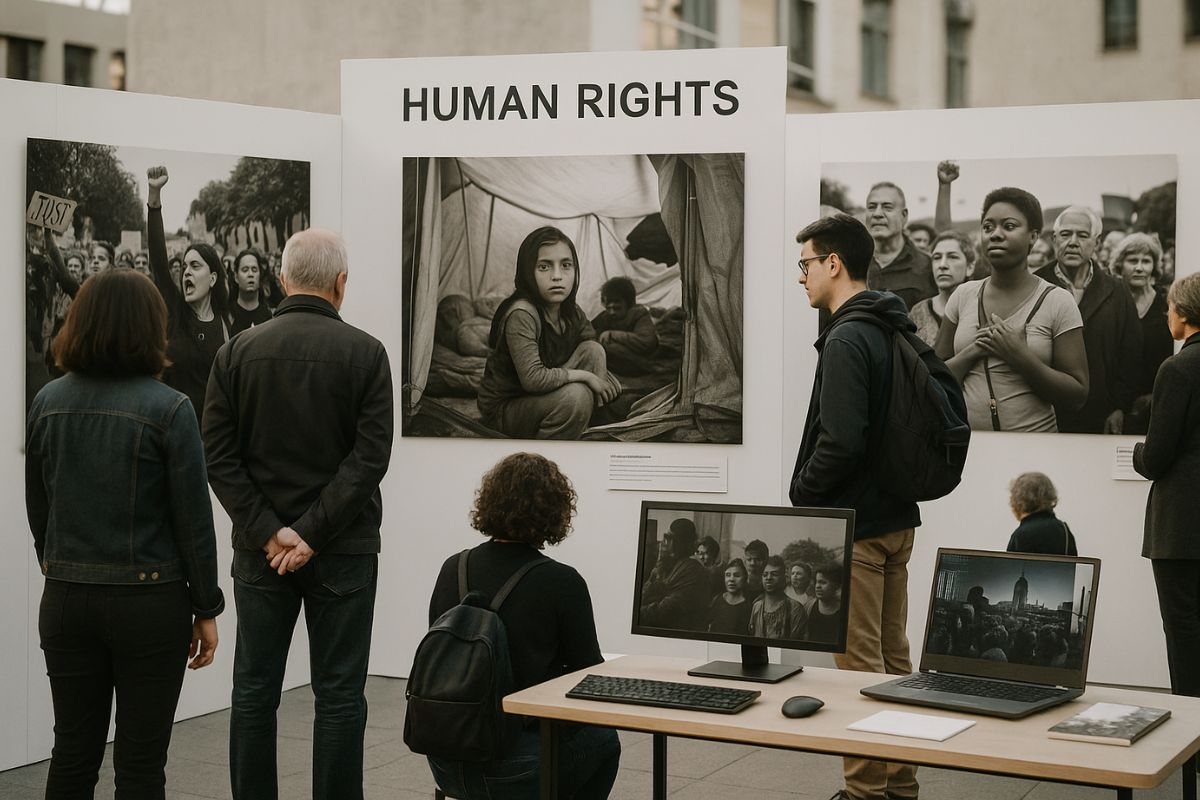
Organize Human Rights Photo Exhibits
Photographs have a unique ability to move people. Unlike reports or speeches, an image can create an instant emotional connection. For human rights work, this matters. Photos bring the lived experience of injustice into focus. They give faces to stories that often feel distant or abstract.
Organizing a human rights photo exhibit is not just about showing pictures. It’s about building empathy, sparking dialogue, and inviting people to care—and act. Whether you’re part of a grassroots organization or an established NGO, a well-curated exhibit can make a lasting impact in your community.
What This Article Covers
This article looks at the purpose and process of organizing human rights photo exhibits. You’ll learn how to choose a focus, gather strong visuals, partner with the right voices, and make the experience accessible. It’s also about treating the subjects of the photos with dignity and care, and honoring their stories throughout the process.
Whether your goal is education, awareness, or advocacy, a photo exhibit can turn an empty wall into a space for solidarity and conversation.
Start with a Clear Message
Before selecting images or choosing a venue, think about what the exhibit should say. Is it about displacement, gender-based violence, or environmental injustice? Is it focused on a single region, or does it bring together multiple issues?
A strong message helps shape the exhibit and makes it easier for visitors to follow. It also guides your choices on tone, layout, and supporting materials.
You don’t need to cover everything. Focus helps the story come through clearly, allowing each photo to speak without being lost in a flood of unrelated content.
Work with Photographers and Communities
The most powerful human rights images often come from people directly affected. That might mean working with photojournalists who’ve spent time documenting crises—or it might mean partnering with community members who’ve taken photos themselves.
Whenever possible, include the voices of those in the photos. Ask for consent. Share drafts of captions or layouts. Make sure participants know how their stories will be shown and have a say in how they’re represented.
This approach builds trust and results in exhibits that feel more honest and grounded. It’s not just about showing struggle—it’s about sharing experience.
Choose a Space that Fits the Purpose
Where the exhibit happens changes who sees it and how it feels. A university gallery, a community center, a public park—each brings a different audience and level of formality.
Consider who you want to reach. If the goal is to engage local residents, a space in the neighborhood might work better than a formal gallery downtown. If you want to reach decision-makers or journalists, a central location near government or media buildings might make more sense.
Also think about layout. Give each photo room to breathe. Use lighting and spacing to guide people through the story. Include benches, if possible, for people to sit with the emotions the photos may bring up.
Add Context Without Taking Over
Photos can speak for themselves—but context deepens their meaning. Include short captions that explain what’s happening, who is involved, and why the moment matters. Avoid long blocks of text. Let each word support the image.
Quotes from people in the photo, maps, and timelines can help as well. If you’re working with sensitive topics, include a content note at the entrance so visitors can prepare themselves.
Remember, your job is not to explain everything. It’s to invite reflection and offer enough information for people to understand and care.
Make It Accessible
Exhibits should welcome everyone. That means thinking about physical access—ramps, clear paths, and seating—but also visual and language access. Large fonts, alternative text for digital displays, and translations can all make a difference.
If you’re hosting an online version, make sure it works on mobile and includes captions or transcripts for any videos. Keep loading times short, and avoid auto-playing sound or motion that could distract or overwhelm visitors.
Offer audio guides or guided tours for people who want more information. And provide clear instructions for how to reach out with questions or feedback.
Encourage Action, Not Just Reflection
A photo exhibit should move people—but it can also give them something to do. Include a space near the end with suggestions: how to donate, how to volunteer, how to learn more, or how to join local campaigns.
This doesn’t have to be a big display. Even a simple table with flyers, a QR code linking to a petition, or a sign-up sheet can help channel emotion into action.
Some exhibits include a message wall where visitors can write thoughts or commitments. Others use art supplies so people can respond creatively. These touches help turn the exhibit into a shared space of care and resistance.
Document the Exhibit for the Long Term
Photos of your exhibit can extend its reach. They give you something to share with partners, funders, and new audiences. They also show respect for the work that went into the project—especially from volunteers, photographers, and community members.
Be thoughtful about what you document. Focus on the layout, the reactions of visitors (with permission), and moments that reflect the spirit of the event.
Consider creating a small online version after the exhibit ends. This helps people who couldn’t attend engage with the message in their own time.
Organizing a human rights photo exhibit is more than an event. It’s a way to hold space for stories that deserve to be seen and felt. Done with care, it reminds people that human rights are not abstract ideas—they are lived realities. And they belong to all of us.
